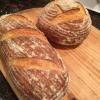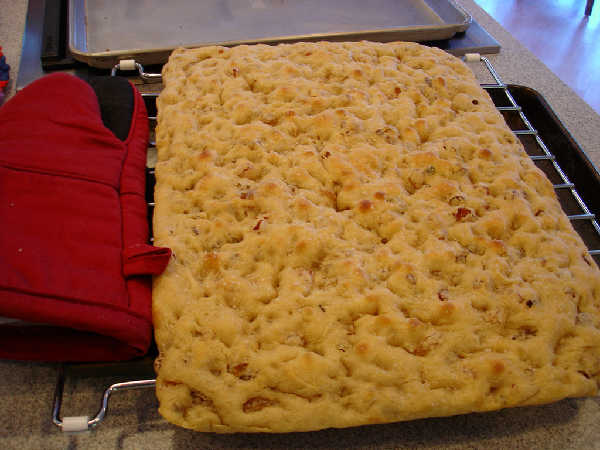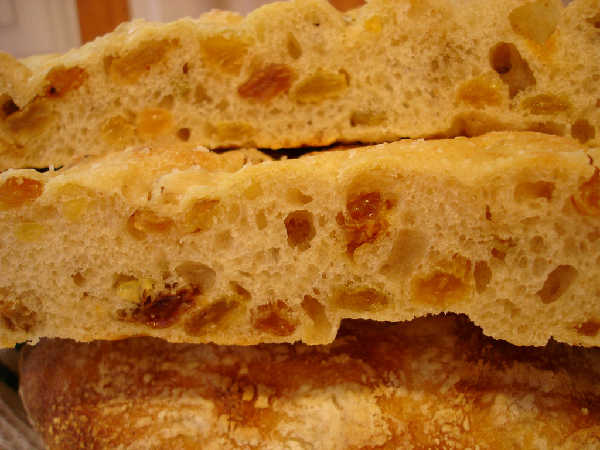
Whole wheat sourdough bagels

The best bagels I've ever had were not from New York or New Jersey, or even Philadelphia. They came from a tiny bagel shop in Winston-Salem, NC. I'm not even sure what it's name was; we just called it, "The Bagel Place."
There's no doubt, though, they made the "real thing". Beautifully chewy water bagels with the traditional toppings: plain, poppy seed, garlic, onion, sesame -- and, of course, all the newfangled kinds as well: cinnamon raisin, asiago cheese, chocolate chip, tobacco.
Just kidding about tobacco, of course, though when you live in the hometown of RJ Reynolds Tobacco Corp., the aroma of tobacco tends to permeate the air, especially if a storm is coming in, because the wind changes direction and blows directly over the cigarette factories outside of town.
Tobacco winds or no, the bagels were delicious, and have formed my ideal for what a bagel ought to be. Of course, I may have been a bit biased. I met the baker contra dancing, and he became a good friend: Joe Bagel, we called him. He taught me that bagels should be boiled and then baked good and hot.
I've never had any luck, however, finding a 100% whole wheat bagel that tasted ... good. All the whole wheat bagels I bought had a strong bitter aftertaste, a taste that I now know comes from using whole wheat flour that's less than fresh. And more often than not, they were even more dense than a bagel ought to be.
I've tasted some better whole-wheat bagels recently, but they're not 100% whole wheat. So I decided to see if I could make a decent bagel from fresh whole wheat flour. For inspiration and instruction, I looked to both Reinhart's Bread Baker's Apprentice and Hammelman's Bread. I also thought that sourdough might help - it always seems to do so with everything else. The end result is up above. I'm happy to say tha they were, indeed tasty. In fact, my wife didn't know they were whole wheat until I mentioned it to her after she'd eaten breakfast!
As I'd feared, they were not as chewy as I'd like -- need high-gluten flour for that. I think, perhaps, I'll try adding some vital wheat gluten the next time around to see if I can increase the chew factor. Anyway, here's how I made them:
Overall formula
- Whole wheat flour: 100%
- Water: 60%
- Salt: 2%
- Diastatic malt powder: 0.9%
- Pre-fermented flour: 30%
Ingredients
- Whole wheat starter: 220 grams at 60% hydration
- Water: 195 grams
- Whole wheat flour: 320 grams
- Diastatic malt powder: 4 grams
- Salt: 9 grams
- Optional: 1 Tbs baking soda or enough Malt Syrup to turn the Boiling Water the color of tea.
Start the night before you want to bake. Combine the ripe starter with the water and knead them together until the starter is very soft and the water is milky. Add the flour, salt and malt powder. Mix until it turns into a dough. The dough will be dry -- like any dough, if you poke it enough, it'll feel a little tacky, but you don't want any more tackiness than that. It'll be tough to knead, but nonetheless, give it a good 300 strokes. Stiff as it is, a small piece of the dough will form a translucent windowpane when it's fully developed, just make sure you turn the piece of dough in a circle as you stretch it.
Once the dough is developed, form it into a ball, cover it, and let it ferment for about an hour at room temperature. It will not rise much in that time.
Divide the dough into six pieces and shape each piece into bagels. I chose to use the old-style shaping described in Bread. Flatten each into a rough rectangle and then roll them up tightly, after which they need to be rolled out (by hand) into 6 to 8 inch ropes. Wrap the rope around your hand and then seal with your palm.
Once they are shaped, cover them and let them proof at room temperature for another hour. To see if they're ready to proof, use what Reinhart calls "The Float Test": just drop one bagel gently into a bowl of water. If it floats after 3 seconds or so, it's ready! Dry the test bagel off gently and put them all on a cookie sheet that's wither lined with parchment paper or lightly dusted with cornmeal or semolina flour. Cover with plastic and pop them in the fridge.
The next morning, preheat the oven and a stone, if you've got on, to 500 degrees F and put a big pot of water on to boil. Once the water is good and boiling, add the optional ingredients to the water, if desired. The baking soda acts as a sort of low-grade food-safe lye, and gives the bagels a nice shiny sheen. The malt syrup adds color and flavor. You can add both if you wish, but the water will foam as the acid in the syrup and the baking soda react. What's most important is the boil itself.
The bagels will float. Boil them for about 1 minute on either side. When boiled, you may then top them with seeds, salt, garlic, whatever suits your fancy. I like poppy seed, myself. My wife prefers garlic.
Once they've been boiled and topped, they're ready to bake. I baked mine right on my stone for about 18 minutes, and then let them cool for 10. Have cream cheese and lox ready at hand.






 Sourdough Focaccia
Sourdough Focaccia Sourdough Raisin Focaccia (a)
Sourdough Raisin Focaccia (a) Sourdough Focaccia Crumb
Sourdough Focaccia Crumb 

